Heavy mortars are large-calibre mortars designed to fire a relatively heavy shell on a high angle trajectory. Such weapons have a relatively short range, but are usually less complex than similar calibre field artillery.
This category includes the "Trench Mortars" of World War I which were all too heavy and cumbersome, and hence lacked the mobility, to be classed as infantry mortars.
Thor was a 600mm-caliber heavy mortar used by the German Army during World War II. This self-propelled artillery piece was one of a series of seven 60 cm mortars known as Karl Gerät (040). Designed and developed by Rheinmetall between 1937 and 1940, six of these seven powerful mortars were used during Operation Barbarossa, on the Eastern Front, taking part in the siege of Brest Fortress, the siege of Sevastopol, and the siege of Warsaw during the Polish uprising. They were called "Thor", "Loki", "Odin", "Ziu", "Adam", and "Eva".
Thor had a 5.07m-long barrel, a hydro-pneumatic recoil, and a horizontal sliding-wedge breech. It moved on tracks and was powered by a Daimler-Benz MB 507 C diesel engine, delivering 580 horsepower; for long distances it was transported by railways. Thor fired 2,170-kg concrete piercing shells to a range of 6.5 km (7 miles) with an elevation of 60°. These shells could penetrate 2.5m-thick reinforced concrete and 350mm-thick steel armor.
Specifications
Type: heavy siege mortar Country of origin: Germany Manufacturer: Rheinmetall Weight: 124 metric tons Caliber: 600mm (60 cm) Barrel length: 5.02 m Breech: horizontal sliding-wedge Range: 6.5 km Rate of fire: six rounds per hour Engine: Daimler-Benz MB 507 C diesel, 580 hp
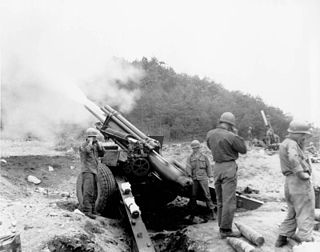
A howitzer is generally a large ranged weapon between an artillery gun – which has smaller, higher-velocity shells fired at flatter trajectories – and a mortar – which fires at higher angles of ascent and descent. Howitzers, like other artillery equipment, are usually organized in a group called a battery.

A mortar is usually a simple, lightweight, man-portable, muzzle-loaded weapon, consisting of a smooth-bore metal tube fixed to a base plate with a lightweight bipod mount and a sight. They launch explosive shells in high-arcing ballistic trajectories. Mortars are typically used as indirect fire weapons for close fire support with a variety of ammunition.

A shell is a projectile whose payload contains an explosive, incendiary, or other chemical filling. Originally it was called a bombshell, but "shell" has come to be unambiguous in a military context. Modern usage sometimes includes large solid kinetic projectiles that is properly termed shot. Solid shot may contain a pyrotechnic compound if a tracer or spotting charge is used.

The formal definition of large-calibre artillery used by the United Nations Register of Conventional Arms (UNROCA) is "guns, howitzers, artillery pieces, combining the characteristics of a gun, howitzer, mortar, or multiple-launch rocket system, capable of engaging surface targets by delivering primarily indirect fire, with a calibre of 75 millimetres and above". This definition, shared by the Arms Trade Treaty and the Treaty on Conventional Armed Forces in Europe, is derived from a definition in United Nations General Assembly Resolution 46/36L, which set a threshold of 100mm. Several grammatical changes were made to that latter in 1992 and the threshold was lowered in 2003 to yield the current definition, as endorsed by UN General Assembly Resolution 58/54.

A rifled breech loader (RBL) is an artillery piece which, unlike the smoothbore cannon and rifled muzzle loader (RML) which preceded it, has rifling in the barrel and is loaded from the breech at the rear of the gun.
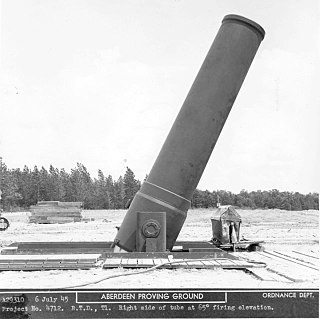
Little David was the nickname of an American 36-inch caliber mortar designed to breach the Siegfried Line and then used for test-firing aerial bombs during World War II. With the same calibre as the British Mallet's Mortar, constructed in May 1857, it is one of the largest-calibre guns ever built, having a larger calibre than both of Germany's Schwerer Gustav and Dora which were 31.5-inch (800 mm) railway guns.

"Karl-Gerät" (040/041), also known as Mörser Karl, was a World War II German self-propelled siege mortar (Mörser) designed and built by Rheinmetall. Its heaviest munition was a 60 cm (24 in) diameter, 2,170 kg (4,780 lb) shell, and the range for its lightest shell of 1,250 kg (2,760 lb) was just over 10 km (6.2 mi). Each gun had to be accompanied by a crane, a two-piece heavy transport set of railcars, and several modified tanks to carry shells.
The Landkreuzer P 1500 Monster was a purported German pre-prototype super-heavy self-propelled gun designed during World War II. While mentioned in some popular works, there is no solid documentation for the program’s existence, and it may be an engineer’s amusement or an outright hoax.

The 240 mm Trench Mortar, or Mortier de 240 mm, was a large calibre mortar of World War I. An original French design, it was developed by Batignolles Company of Paris and introduced in 1915.
The 10 cm PAW 1000 - later re-designated 10H64 - was a lightweight anti-tank gun that utilized a high-low pressure system to fire hollow charge warheads.
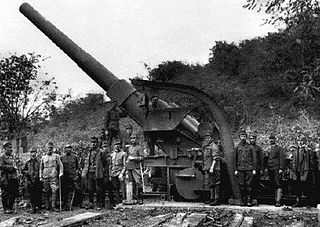
The 24 cm Kanone M. 16 was a super-heavy siege gun used by Austria-Hungary during World War I and by Nazi Germany during World War II. Only two were finished during World War I, but the other six were completed in the early twenties and served with the Czechoslovak Army until they were bought by the Germans after the German occupation of Czechoslovakia in 1938. During World War I, one gun served on the Western Front and the other on the Italian Front. During World War II, they saw action in the Battle of France, Operation Barbarossa and the siege of Leningrad.

The 280 mm mortar M1939 (Br-5) was a Soviet heavy artillery piece used during World War II, it was the Red Army's heaviest field piece during the war.

In artillery, caliber or calibre is the internal diameter of a gun barrel, or - by extension - a relative measure of the barrel length.

The Soviet 240 mm mortar M240 is a 240 millimeter breech loading smoothbore heavy mortar that fires a 130 kilogram projectile.

The 8-inch mortar M1877 was a Russian 203 mm (8 in) coastal, fortress and siege mortar that was used in the Russo-Japanese War and World War I.

The 9-inch mortar M1877 was a Russian 229 mm (9 in) coastal, fortress and siege mortar that was used in the Russo-Japanese War and World War I.

The 21 cm Mörser 99 was a German siege mortar built by Krupp which served during World War I. The mortar utilized a new nickel-steel alloy of greater strength than other cast cannons, though it lacked a recoil mechanism. While the gun was more effective than previous models, it was soon phased out because of improved field artillery and counter-battery fire, though it remained in service in limited numbers throughout the war because of heavy German losses.

The 7.7 cm Leichte Kraftwagengeschütze M1914 was an early German self-propelled anti-aircraft gun developed before and used during the First World War. Static and trailer mounted versions of the gun were designated 7.7 cm FlaK L/27.
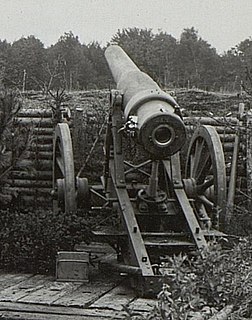
The 15 cm Ring Kanone C/72 was a fortress and siege gun developed after the Franco-Prussian War and used by Germany and Portugal before and during World War I.
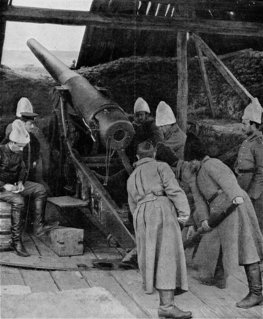
The 15 cm Ring Kanone C/92 was a fortress and siege gun developed in the 1880s that saw service in the Italo-Turkish War, Balkan Wars, and World War I.